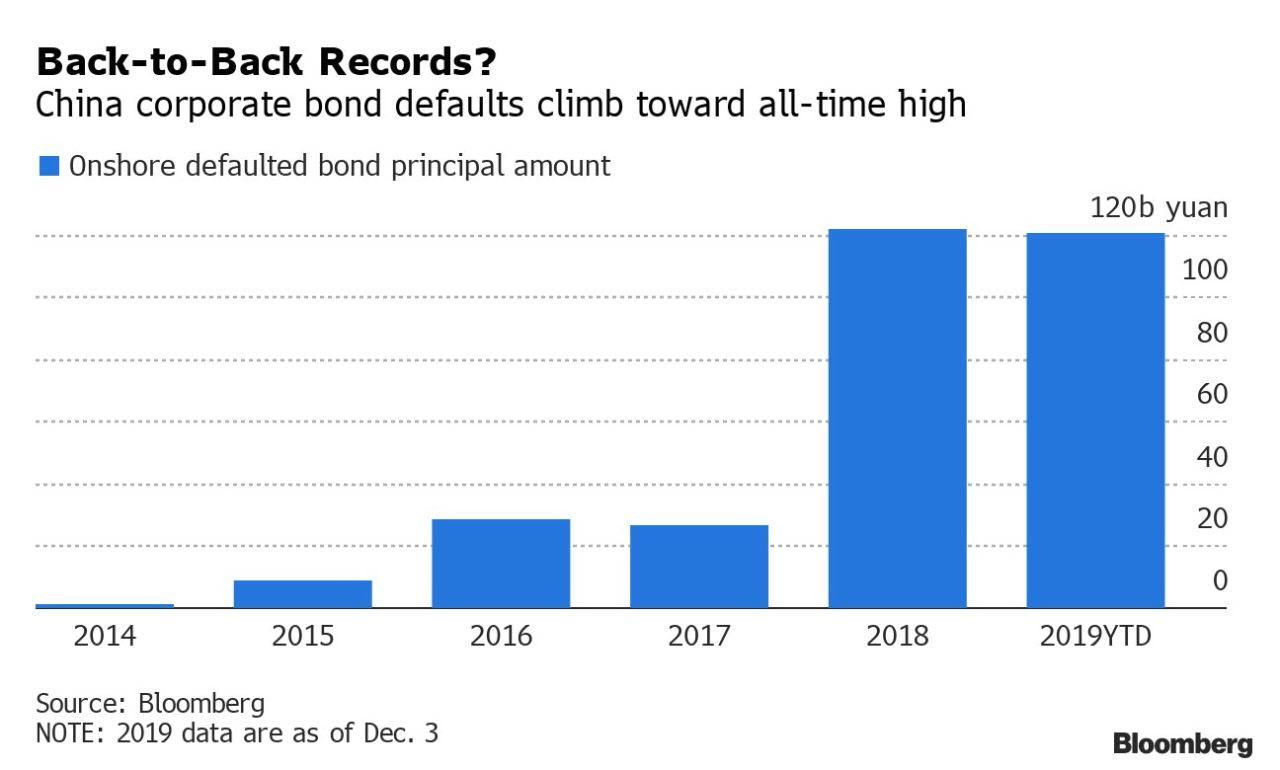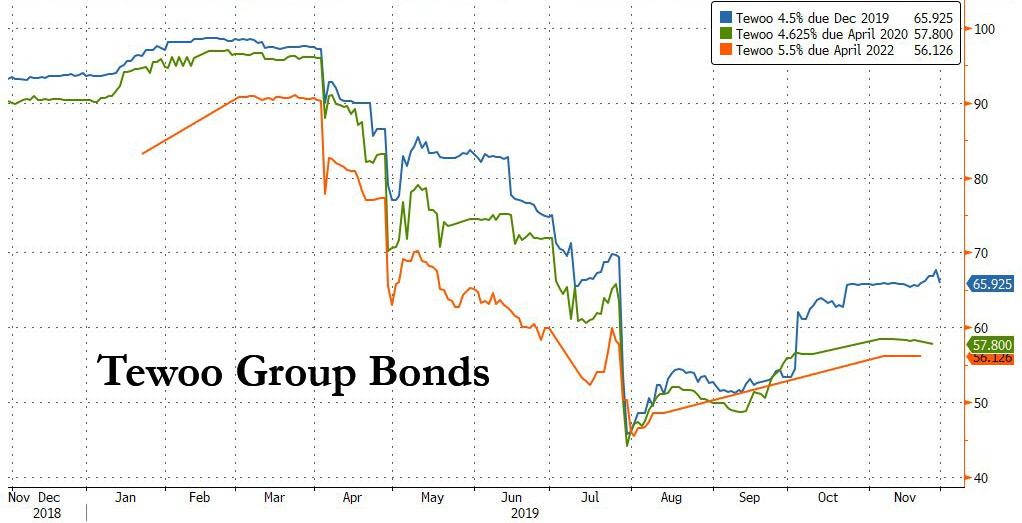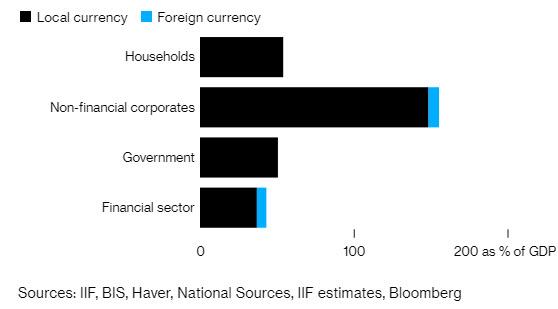China Set To Make History With Record Number Of Bond Defaults In 2019
While China is bracing for what may be a historic D-Day event on December 9, when the “unprecedented” default of state-owned, commodity-trading conglomerate Tewoo with $38 billion in assets may take place, it has already been a banner year for Chinese bankruptcies.
According to Bloomberg data, China is set to hit another dismal milestone in 2019 when a record amount of onshore bonds are set to default, confirming that something is indeed cracking in China’s financial system and “testing the government’s ability to keep financial markets stable as the economy slows and companies struggle to cope with unprecedented levels of debt.”
After a brief lull in the third quarter, a burst of at least 15 new defaults since the start of November have sent the year’s total to 120.4 billion yuan ($17.1 billion), and set to eclipse the 121.9 billion yuan annual record in 2018.
The good news is that this number still represents a tiny fraction of China’s $4.4 trillion onshore corporate bond market; the bad news is that the rapidly rising number is approaching a tipping point that could unleash a default cascade, and in the process fueling concerns of potential contagion as investors struggle to gauge which companies have Beijing’s support. As Bloomberg notes, policy makers have been walking a tightrope as they try to roll back the implicit guarantees that have long distorted Chinese debt markets, without dragging down an economy already weakened by the trade war and tepid global growth.
“The authorities have found it hard to rescue all the companies,” said Wang Ying, a Shanghai-based analyst at Fitch Ratings, perhaps envisioning at least two banks that have experienced depositor runs in the month of November in the aftermath of an unprecedented succession of bank failures earlier in the year.
It’s not just banks however: this year’s debt woes have spread to a broad array of industries, from property developers and steelmakers to new-energy firms and software makers. The types of borrowers facing repayment difficulties has also expanded from private companies and local state-run firms to business arms of universities, an obscure and loosely regulated corner of China’s corporate world.
China’s two latest defaults involved just such a company; on Monday Peking University Founder Group shocked investors after failing to repay a 2 billion yuan bond. The same day, Tunghsu Optoelectronic Technology, a maker of photoelectric display components, also failed to deliver early repayment on both interest and principal for a 1.7 billion yuan note.
Meanwhile, as we reported last week, the signs of stress have ominously spread to China’s offshore market, which has so far been more insulated from defaults: next week, Tewoo Group, a Fortune 500 company and major commodities trader from the northern city of Tianjin, is set to become the most high profile state-owned enterprise to default in the dollar bond market in more than two decades.
The company has recently offered a debt restructuring plan that entails deep losses for investors or a swap for new bonds with significantly lower returns, the first of its kind for an offshore SOE issuer. On December 9, Tweoo bondholders need to decide if they accept a distressed exchange offer on a $300 millionbond that is likely to default on Dec. 16.
Still, despite the drumbeat of bad news, analysts remain cheerful and claim the threat of a systemic debt crisis in China remains distant.
“I don’t think it is a tipping point,” Bank of Singapore managing director Todd Schubert said. “China is a big market with a lot of issuers. In a functioning capital market, one would naturally expect some defaults.”
And while China is set to make a new record in the amount of default, the lack of a substantial increase from last year means that China’s onshore default rate is expected to remain the same as last year’s 0.5%, according to S&P.
Not that Beijing has much of a choice of course: faced with a non-financial corporate debt pile that swelled to a record 165% of GDP year, Chinese policy makers are selectively allowing more bond failures in part to impose increased discipline on borrowers and investors. But not too much discipline, as the alternative could be a panic across the country’s bond market.
“Rising defaults should be a natural part of credit-market cycle,” said Anne Zhang, head of Asia fixed income for JPMorgan Private Bank. “It is long-term positive for any market to develop a good pricing mechanism for risks.”
The problem is that for Beijing it still remains a highly selective process, picking winners and losers at will; to be sure, the process would be less rocky for investors if policymakers could improve the transparency around defaults, according to Cindy Huang, an analyst at S&P Global Ratings.
“The regulators’ intention is to reduce moral hazard” while at the same time ensuring any defaults “won’t undermine socioeconomic stability or trigger systemic risks,” said Ivan Chung, head of greater China credit research and analysis at Moody’s, adding that whereas state support may be available for companies engaged in social welfare projects, for those that are more commercial in nature, “government support may not be so forthcoming.”
“So far, defaults and recovery can be unpredictable,” Huang said. “This will hinder market confidence and weaken the healthy development of China’s credit market.”
Which is why when it comes to Chinese corporate defaults, there is just one certainty looking ahead: there will be many more of them. In fact, Moody’s expects 40-50 new defaults in 2020, up from 35 this year. Considering that China is set to post its first sub-6% GDP growth year in history in 2020, this will prove an overly optimistic forecast.
Tyler Durden
Wed, 12/04/2019 – 21:35
![]()
Zero Hedge’s mission is to widen the scope of financial, economic and political information available to the professional investing public, to skeptically examine and, where necessary, attack the flaccid institution that financial journalism has become, to liberate oppressed knowledge, to provide analysis uninhibited by political constraint and to facilitate information’s unending quest for freedom. Visit https://www.zerohedge.com


